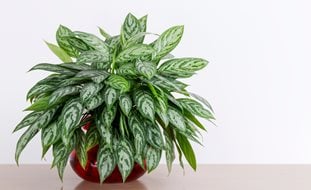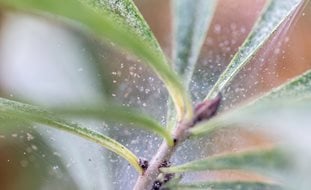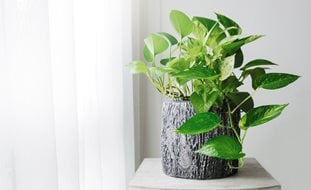How to Grow Clusia Plants Indoors
This handsome tropical tree also makes a great houseplant. Get growing and care tips and learn more about its special attributes. Published 7/27/2022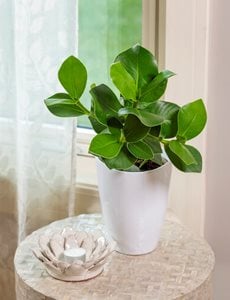
Tattoo™ Princess autograph tree. Photo by: Proven Winners.
Autograph tree (Clusia rosea) may just be one of coolest houseplants that you’ve never heard of. Hailing from the tropics, this ultra-trendy tree is starting to show up in nurseries and garden centers everywhere, and is well worth seeking out if you’re looking for a lush, leafy houseplant that is remarkably easy to care for.
As the name suggests, autograph tree’s most unique feature is its ability to be personalized. You can actually carve your name or initials into one of its thick, leathery leaves and the writing will remain, even as the leaf grows in size.
It also has a nice, full shape, with leaves and branches that extend symmetrically from a sturdy central stalk. Another plus: Autograph tree is one of the few houseplants capable of absorbing carbon dioxide at night and converting it into oxygen, making it a super-efficient indoor air purifier.
On this page: Basics | Growing Tips | Care | Propagating | Growing Outdoors
BASICS
Botanical name:
Clusia rosea (Not to be confused with Clusia guttifera, or small leaf clusia, a similar species commonly grown outdoors as a shrub or hedge.)
Common names:
Autograph tree, balsam apple, pitch apple, Scotch attorney, signature tree, Florida clusia
Origin:
Native to southern Florida as well as the West Indies, Mexico, and Central America
Growth rate:
Fast
Size:
When grown in pots indoors, it rarely grows taller than 3 or 4 feet, but can reach heights exceeding 30 feet when grown outdoors in its native habitat.
Foliage:
Usually deep olive green and paddle-shaped, growing up to 8 inches in length. There’s also a cultivar with striking yellow and green variegated foliage (Clusia ‘Variegata’), but it can be difficult to find.
Flowers:
Plants rarely bloom indoors, but may develop light pink and white flowers when grown outdoors, followed by small apple-like fruits.
Is autograph plant toxic?
The fruit of the autograph tree is considered to be the most toxic part, but the foliage can also cause gastrointestinal upset if ingested. Keep out of reach of children and pets. (See this guidance from the ASPCA.)
Interesting fact:
Clusia rosea is a hemiepiphyte, which means it often begins life as an epiphyte growing on other trees, obtaining all its moisture and nutrients from the air and rain. It eventually develops hanging aerial roots that reach the ground and take root in the soil.
GROWING CLUSIA
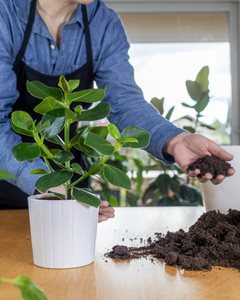
Photo by: Benoit GVA / Shutterstock
Light:
Clusia rosea prefers medium to bright indirect light, such as from an east- or west-facing window or set back from a south-facing window. Avoid giving it too much direct sunlight, which can scorch the leaves.
Temperature and humidity:
Autograph tree loves greenhouse-like conditions, with room temperatures between 60° to 85° F and high humidity levels. Keep away from cold drafts, and don’t expose plants to temperatures below 50° F. Also avoid placing near heating or cooling vents. In drier areas of the home, keep your plant hydrated by using a humidifier, misting the leaves regularly, or setting the pot on a shallow tray filled with pebbles and water.
Soil:
Use a loose, fast-draining soil that allows for good root aeration, such as a high-quality potting mix augmented with coconut coir or orchid bark to improve drainage.
Pot requirements:
Grow in a pot that is 2 to 4 inches wider and deeper than the root ball, with adequate drainage holes. Giving the roots enough room to spread will result in faster, more robust growth. If your plant becomes rootbound, the growth will be slower.
HOW TO CARE FOR AUTOGRAPH PLANT
Watering:
Keep the soil lightly moist, watering whenever the top inch of soil feels dry to the touch. Add water until it begins to flow out of the pot’s drainage holes, being careful not to allow the roots to sit in soggy soil, which can lead to root rot. Clusia rosea isn’t sensitive to the minerals in water, so it’s fine to use ordinary room-temperature tap water.
Fertilizing:
Feed once a month with a water-soluble plant food diluted to half strength when the plant is actively growing. Withhold fertilizer during the winter.
Pruning:
Because of its fast growth rate, Clusia rosea may need to be pruned once or twice a year to maintain the desired shape and prevent it from becoming leggy. Using clean hand pruners, cut back the stems to just above a pair of leaves; this will encourage branching and fuller, bushier growth. You can save the stem cuttings to propagate new plants.
Repotting:
You may need to repot your autograph tree every year or two to prevent it from outgrowing its container. If you notice roots growing out of the drainage holes at the bottom of the container, it’s time to repot. Move your plant to a new container about 2 inches larger than the existing one, and be sure to refresh the soil.
Leaf damage:
If your autograph tree has yellow or discolored leaves, it’s usually due to stress caused by over or underwatering, low humidity, temperature fluctuations, or too much direct sunlight. Prune off the damaged foliage and only give your plant enough water to keep the soil slightly moist but not soggy.
Common pests:
Autograph tree rarely encounters serious pest or disease problems, but it may occasionally be infested by spider mites, mealybugs, aphids, and scale. See how to identify and treat these and other common houseplant pests.
PROPAGATING CLUSIA
Clusia rosea is easy to propagate from stem cuttings rooted in water or soil. The best time of year to propagate is during spring and summer, when the plant is actively growing.
Propagating in water:
Take a stem cutting about 4 to 6 inches long that has several healthy leaves on it. Place the cutting in water, making sure the foliage is above the waterline, and change the water every few days to prevent bacteria from forming.
Propagating in soil:
Fresh stem cuttings will also take root if planted directly in a high-quality potting mix, as long as you keep the soil evenly moist. Poke a hole into the soil for each cutting and insert the bottom of the stem, leaving the foliage above the soil. Keep the cuttings in a warm place and water regularly so the soil doesn’t dry out.
Growing hydroponically:
It’s also possible to grow Clusia rosea hydroponically in a glass vase filled with water and forgo the soil altogether. This is one of the easiest methods of growing an autograph tree, and one of the most attractive because it allows you to show off its intricate root system. It also offers the advantage of preventing under or overwatering because you simply add more water to the vase as needed to make sure the roots are always covered.
Once a stem cutting takes root in water it can often survive for months as long as you add a few drops of liquid fertilizer to the water occasionally to give your plant the nutrients it needs for healthy growth.
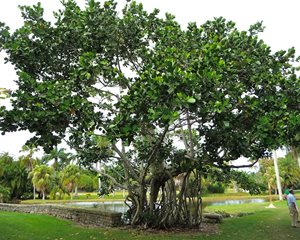
Photo: Kyle Wicomb / Flickr.
GROWING CLUSIA OUTDOORS
In coastal areas of the deep South (Zones 10-11), Clusia rosea is often grown in the garden as a salt-tolerant evergreen shade tree or privacy hedge. There is also an attractive dwarf variety (C. rosea ‘Nana’), excellent for use as a compact bush or shrub.
If you live in a colder climate, you can grow autograph tree as a potted plant on a sunny porch or patio during the summer months and move it indoors over winter.
Note that autograph tree has a tendency to naturalize aggressively by reseeding. The Florida Native Plant Society
